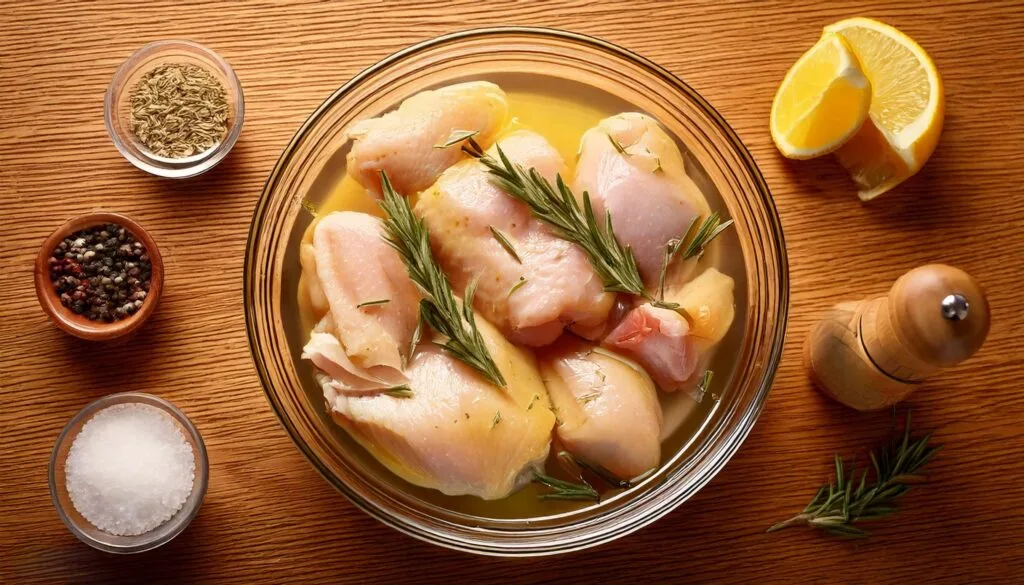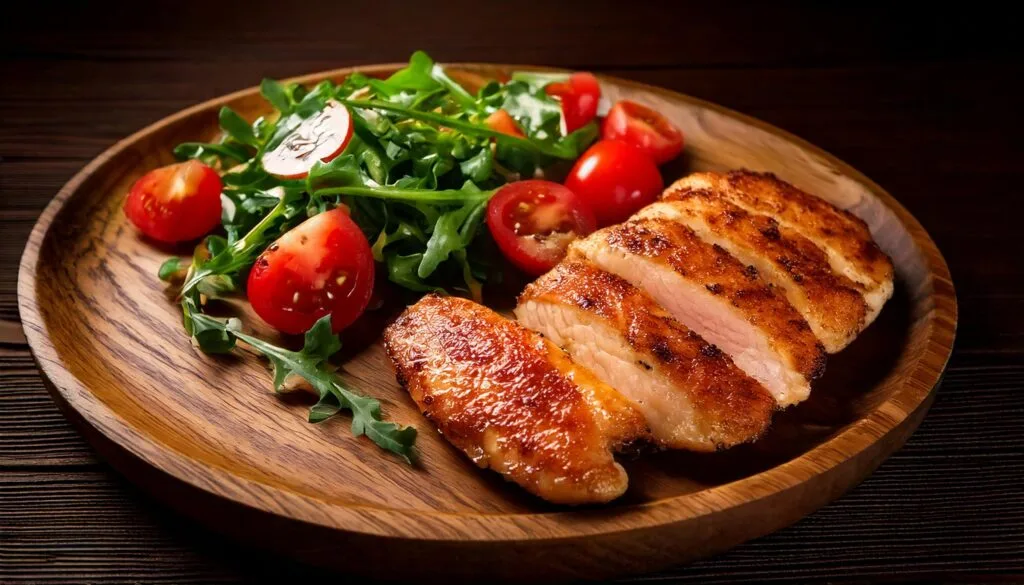Cooking chicken to achieve that perfect tenderness can seem like an elusive art. We’ve all been there: dry, chewy chicken that barely resembles the juicy, tender bite we crave. But here’s the secret you don’t need to be a professional chef to nail this! With the right preparation, cooking methods, and a touch of know-how, you can turn every chicken dish into a tender masterpiece.
In this article, I’ll guide you through every step, from preparing your chicken to post-cooking tips. You’ll learn everything from the best marination techniques to ideal cooking temperatures, ensuring that your chicken stays juicy every time. Let’s dive in!
Preparing Chicken for Maximum Tenderness
Why Proper Preparation Matters
Before we even get to the stove, preparation is key. The way you prep your chicken can make or break its tenderness. A common mistake people make is skipping this crucial step, thinking cooking is all that matters. But here’s the deal prepping ensures the fibers of the chicken stay soft and absorb moisture, which means no more rubbery results.
Choosing the Right Cut of Chicken
When it comes to tender chicken, not all cuts are created equal. Bone-in thighs tend to be naturally juicier because of their higher fat content, while breasts, though lean, can dry out faster. But don’t worry breasts can still turn out tender if treated properly. Pro tip? Use chicken thighs for dishes requiring long cooking times and breasts for quick meals.
Marination Techniques for Tender Chicken
Marination isn’t just for flavor it’s a game-changer for tenderness. Acidic marinades, like those with lemon juice or yogurt, help break down proteins, softening the meat. Enzymatic marinades using pineapple or papaya take it a step further, offering melt-in-your-mouth results. However, timing matters: too long in an acidic marinade can turn your chicken mushy. Aim for 30 minutes to 4 hours, depending on the strength of the marinade.
Cooking Methods for Tender Chicken
How to Use Brining for Tenderness
Brining is one of the most effective techniques to ensure your chicken turns out moist and tender every time. Essentially, a brine is a saltwater solution that infuses chicken with moisture while breaking down muscle fibers. This makes the meat juicier and more flavorful.
You can choose between a basic salt brine or a buttermilk brine. Salt brines are easy just dissolve 1/4 cup of salt per quart of water, submerge your chicken, and let it sit for 1–4 hours. Buttermilk brine, on the other hand, not only tenderizes but also adds a subtle tangy flavor.
Ideal Cooking Temperatures for Juicy Chicken
Cooking chicken to the correct internal temperature is critical to retaining tenderness. Overcooking dries it out, while undercooking can leave it unsafe to eat. A meat thermometer is your best friend here insert it into the thickest part of the chicken. For perfect results:
- Breasts: Cook to 165°F (74°C).
- Thighs: Aim for 170–175°F (77–79°C).
Cooking at slightly lower temperatures for bone-in pieces ensures the juices stay locked in.
Cooking Techniques That Deliver Tender Chicken
Here’s where the magic happens! Different cooking methods can yield equally tender results if executed well.
• Low and Slow Cooking:
Methods like braising or slow cooking are perfect for tough cuts like thighs. These techniques give the collagen in the chicken time to break down, resulting in a melt-in-your-mouth texture. Add a splash of broth or sauce for moisture.
• High-Heat Methods:
Grilling, searing, and roasting work wonders when paired with proper basting. Searing locks in juices, and roasting at 400°F (204°C) for a shorter time keeps the meat tender. Just make sure not to leave the chicken unattended!
• Sous Vide Precision Cooking:
This modern approach involves vacuum-sealing chicken and cooking it in a water bath at a controlled temperature. It’s foolproof and guarantees the chicken stays juicy.
Adding Fat and Moisture While Cooking
Chicken, especially breasts, benefits from added fat during the cooking process. Brush on olive oil or melt butter over the top to keep the surface moist. A touch of butter can elevate flavors, and understanding its uniqueness can help create better recipes. Basting every 10–15 minutes while roasting can elevate the flavor and tenderness.
Post-Cooking Tips for Tender Chicken

Resting Your Chicken After Cooking
One of the most overlooked steps in cooking tender chicken is letting it rest. After you’ve removed the chicken from the heat, resist the urge to slice it right away! Resting allows the juices to redistribute throughout the meat, ensuring every bite is juicy and flavorful.
- For smaller cuts, rest for about 5–10 minutes.
- For larger cuts or whole chickens, rest for 15–20 minutes.
During this time, tent the chicken loosely with foil to retain warmth without causing it to steam.
Cutting Chicken the Right Way
How you slice your chicken can make a huge difference in the texture. Always slice against the grain, which means cutting perpendicular to the natural muscle fibers. This breaks up the fibers and makes each bite feel tender and easy to chew.
Storing Leftovers Without Losing Tenderness
If you have leftover chicken, storing it properly will help keep it tender when reheating. Place the chicken in an airtight container and add a splash of chicken broth or a pat of butter before sealing it to lock in moisture. When it’s time to reheat, avoid using the microwave if possible. Instead, warm the chicken gently in a skillet with a little water or broth over low heat, or cover it in the oven at 300°F (150°C) to prevent it from drying out. Reheating is also a breeze in an air fryer whether it’s leftover chicken or nachos, the air fryer works wonders to keep everything juicy and crispy!
Common Mistakes That Make Chicken Tough
Overcooking the Chicken
One of the most frequent culprits of tough chicken is overcooking. Chicken breast, in particular, has little fat and cooks quickly, making it prone to drying out. It’s easy to leave it on the stove or in the oven for “just a few extra minutes,” but those minutes are enough to sap the moisture. Always keep an eye on your chicken, and use a meat thermometer to pull it off the heat at the right temperature.
Cooking Chicken Directly from the Fridge
Cold chicken straight from the refrigerator is another common mistake. When the meat is too cold, it cooks unevenly. The exterior will cook faster, leaving the inside raw or tough. For best results, let the chicken sit at room temperature for 20–30 minutes before cooking. This allows for even heat distribution.
Skipping Proper Marination or Brining
Skipping the marination or brining step can also lead to disappointment. These processes not only infuse flavor but also help tenderize the meat. Rushing through this step or skipping it altogether can make your chicken lack both flavor and tenderness.
Not Letting the Pan or Grill Heat Properly
Cooking chicken in a pan or grill that isn’t properly preheated can lead to dryness. A hot pan sears the exterior quickly, locking in juices. If the pan isn’t hot enough, the chicken may cook unevenly, and its moisture will seep out. Heat the pan or grill until it’s hot enough to create a slight sizzle when you add the chicken.
Recipes and Methods for Specific Dishes

How to Cook Tender Chicken Breast
Chicken breast is a favorite for many, but it’s also notoriously easy to overcook. To make it tender and juicy every time:
- Pound the Chicken: Use a meat mallet to flatten the breast for even cooking.
- Marinate Thoroughly: Opt for yogurt or citrus-based marinades to break down proteins and infuse flavor.
- Sear and Finish: Start by searing the chicken in a hot pan for a golden crust, then finish cooking on low heat with a lid to trap moisture.
Cooking Juicy Chicken Thighs
Chicken thighs are naturally juicier due to their higher fat content, but they can still dry out without proper care. Use these tips:
- Bone-In vs. Boneless: Bone-in thighs retain more flavor and moisture when roasted or grilled.
- Braised Perfection: Simmer thighs in a flavorful liquid like broth or coconut milk for tender results.
- Skin-On Crispy Delight: For crispy skin, pat the thighs dry, season well, and cook in a hot skillet without moving them until the skin is golden.
Preparing Tender Chicken Drumsticks
Chicken drumsticks are perfect for both kids and adults and can stay tender if cooked right.
- Roast with Care: Roast at 400°F (204°C) and brush with sauce during the last 10 minutes for a sticky glaze.
- Slow Cook for Flavor: Add drumsticks to a slow cooker with your favorite sauce, and cook on low for 4–5 hours for fall-off-the-bone tenderness.
Perfecting Whole Roasted Chicken
Roasting a whole chicken can seem intimidating, but it’s one of the best ways to achieve tender meat.
- Season Inside and Out: Rub the chicken with a mix of butter, garlic, and herbs both under the skin and inside the cavity.
- Baste Frequently: Brush the chicken with its own juices or melted butter every 20 minutes to keep it moist.
- Use a Rack: Elevating the chicken ensures even cooking and crispy skin.
Tools and Equipment for Tender Chicken
Essential Kitchen Tools for Tender Chicken
The right tools can make or break your chicken-cooking experience. Here are a few must-haves:
- Meat Thermometer: Ensures your chicken is cooked to the perfect internal temperature without overcooking.
- Cast-Iron Skillet: Retains heat evenly, making it great for searing chicken to lock in moisture.
- Sharp Knife: Makes cutting chicken against the grain easier and cleaner.
Using a Sous Vide Machine for Ultimate Tenderness
If you’re serious about tender chicken, investing in a sous vide machine is worth considering. It allows you to cook chicken at a precise, consistent temperature:
- Vacuum-seal the chicken with seasonings.
- Set the sous vide to the desired temperature (e.g., 150°F/65°C for juicy results).
- Finish with a quick sear for added flavor and texture.
Pressure Cooker vs. Slow Cooker for Chicken
Both pressure cookers and slow cookers are great for tenderizing chicken, but they have different strengths:
- Pressure Cooker: Perfect for fast meals, tenderizing chicken in 15–20 minutes.
- Slow Cooker: Great for deep, slow-cooked flavors that develop over hours.
The Benefits of Non-Stick and Stainless Steel Pans
Choosing the right pan is essential:
- Non-Stick Pans: Ideal for lean cuts like chicken breasts, as they reduce the risk of sticking and tearing.
- Stainless Steel Pans: Provide a great sear but require careful temperature control to prevent sticking.
FAQs About Cooking Tender Chicken
What is the Best Temperature to Cook Chicken for Tenderness?
The ideal cooking temperature varies depending on the cut of chicken:
- Chicken breasts should reach an internal temperature of 165°F (74°C) for safety while maintaining juiciness.
- Thighs and drumsticks benefit from being cooked to 170–175°F (77–80°C) to break down connective tissues, resulting in extra tenderness.
Why Does My Chicken Turn Out Dry Even When I Follow Recipes?
This often happens due to subtle errors, such as overcooking, insufficient resting time, or using low-quality chicken. To remedy this:
- Always monitor the cooking time carefully.
- Allow chicken to rest after cooking.
- Choose organic or pasture-raised chicken, as these options tend to retain more moisture.
Can You Make Pre-Cooked Chicken Tender Again?
Yes! Reviving dry chicken is possible by:
- Simmering it in a flavorful broth or sauce.
- Shredding and mixing it with mayonnaise or yogurt for a moist chicken salad.
- Warming it gently in a pan with a splash of water or broth to restore some moisture.
How Long Should I Marinate Chicken?
The length of marination depends on the ingredients:
- Acid-based marinades (lemon, vinegar) should be limited to 2–4 hours to prevent toughening.
- Yogurt or buttermilk marinades can be used for 6–12 hours for optimal tenderness.
What is the Best Way to Reheat Chicken Without Drying It Out?
Reheat chicken gently in an oven set to 300°F (150°C), covered with foil and a splash of broth to retain moisture. For smaller portions, heating in a skillet over low heat works well too. Avoid the microwave, as it can unevenly dry out the meat.
Conclusion: Mastering the Art of Tender Chicken
Cooking chicken to be tender and juicy doesn’t have to be rocket science, but it does require attention to detail and the right techniques. By understanding how different cuts react to heat, utilizing marinades, and experimenting with methods like sous vide, slow cooking, and brining, you can consistently achieve tender chicken every time.
Remember, the key lies in balancing temperature, cooking time, and moisture retention. Don’t forget the value of resting the chicken and cutting against the grain for that final touch of perfection. Whether you’re making a quick weeknight meal or an elaborate dish for guests, these strategies will elevate your chicken game.
Now, it’s your turn! Try these techniques, share your experiences, and enjoy the satisfaction of perfectly tender chicken. Cooking isn’t just about following steps it’s about experimenting, learning, and creating meals that bring people together. So, head to your kitchen and make some magic happen! 👩🍳🐔
